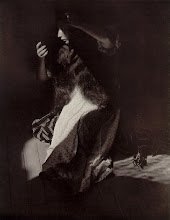
BOBBY PREVITE
The 23 Constellations of Joan Miró
Tzadik 2001
Download
“It was about the time that the war broke out, I felt a deep desire to escape. I closed myself within myself purposely. The night, music and the stars began to play a major role in suggesting my paintings.”
Joan Miró
This piece was originally composed for a multimedia event held in Birmingham, UK in 2004, inspired by unsurprisingly given the title by the 'Constellations' of artist, Joan Miró. Bobby Previte (who I've always found extremely hit and miss as both a composer and drummer/percussionist) was - so the story goes - so amazed by Miró's series after seeing them at a Miró Retrospective at the Museum of Modern Art in 1993 that he felt almost compelled to write a series of his own musical interpretations of the work.
Each of Previte's compositions reflects not only the instability of the gouche paintings, but also the size of each constellation as well (15 by 18 inches) - in quick improvisations, giving a strong immediacy to the music. The major problem for any musician attempting to translate visual art into the aural realm is how to maintain the substance the of the original work, and offer something distinctive in itself. Something I don't think anyone has ever come as close to as Morton Feldman with his beautiful Rothko Chapel compositions.
Looking at art is inevitably more immediate - you can in almost one glance get a sense of the image as a whole - music takes longer to form and to sink into your head, but at the same time to really understand (as far as possible) a painting or other such static visual work you have to spend time looking at it, taking everything in. The image as whole is only a starting point, after that where you go is up to you - your eyes may dart from one detail to the next, they may try to find connections, pick out symmetry or other such arrangements of space, but ultimately this is a very personal response. So what Bobby Previte does brilliantly is reverse this process - so instead of starting out with a whole, you start off with little details, he makes connections, introduces new elements to reflect changes in colour, changes in shape and slowly over the course of his compositions a whole image is formed that somehow stands as equal to the image of the original Miró.
 Joan Miró, Personnages dans la nuit guidés par les traces phosphorescentes des escargots, 1959
Joan Miró, Personnages dans la nuit guidés par les traces phosphorescentes des escargots, 1959
Like Miró's work, Previte's compositions seem to float, a kind reflection of the stars that Miró was so in love with. And like the paintings, Previte's music pulses, wavers, occasionally blisters and bursts through ostinati and glissandi. I suppose it helps that Miró's paintings are in the first place like the work of other artists like Kandinsky similar inspired by musical origins.
Previte does well to maintain a careful balance and harmony created by well-timed counterpoints - 'Acrobatic Dancers' jump around lightly (vibraphone), float in air crafted by the trumpets of Ralph Alessi and Lew Soloff and then quicken their pace as Previte pounds his drums, before eventually returning to ground as Elizabeth Panzer's harp glides celestially from one track to the next - beginning the soft, mournful sounds of 'The Nightingale's Song At Midnight And Morning Rain'. At times, there's a dense cacophony of sounds like those on 'Wounded Personage where Wayne Horvitz's electronics add a sort of 70s retro-futuristic chic to the mix and at others the music becomes reminiscent of a late-night, Eastern European bar room, comic shanty as witness on 'The Poetess'.
Joe Barbato's accordian on 'The Poetess' certainly adds a lighthearted touch, but the composition still maintains the dark undertones, which run throughout Miró's work. The power of which seems to stem from their inherent instability, and their ability to oscillate between light and dark, being paradoxically both welcoming and disquieting in order to reflect the ever changing flux of the world itself. Imagination is the most powerful force behind Miró's work and Previte manages, with each of his compositional responses, to tap into that force, offering a textural tour-de-force of colliding sounds in brief sketches - the longest of which is just over three minutes - which can switch unexpectedly from the gaiety of a major key to the sobriety of minor, opening up the Universe before your ears.





1 comments:
Any chance of re-up of this? Thanks, Bernie
Post a Comment